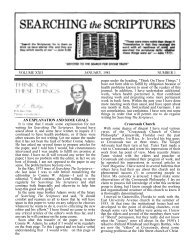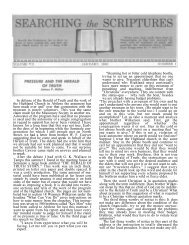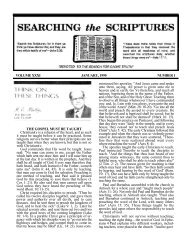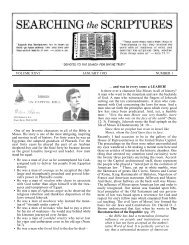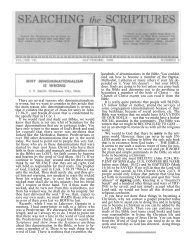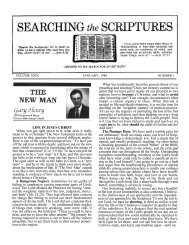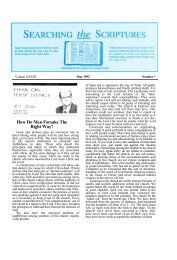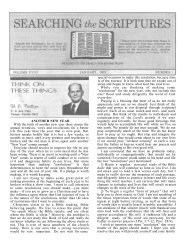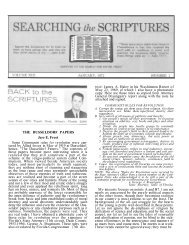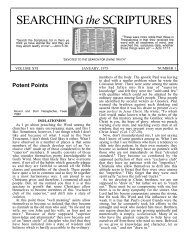In Ephesians 5:22-33, Paul drew an analogy between the ...
In Ephesians 5:22-33, Paul drew an analogy between the ...
In Ephesians 5:22-33, Paul drew an analogy between the ...
You also want an ePaper? Increase the reach of your titles
YUMPU automatically turns print PDFs into web optimized ePapers that Google loves.
____________________________________________________________________________________________________Page 15<br />
<strong>the</strong> enactments of <strong>the</strong> citizens <strong>an</strong>d observe all <strong>the</strong> laws.<br />
They could not tr<strong>an</strong>sact business in <strong>the</strong>ir own name but<br />
had to choose from among <strong>the</strong> citizens one to whose care<br />
<strong>the</strong>y committed <strong>the</strong>mselves as a patron.<br />
<strong>In</strong> Judaism, even proselytes were regarded as<br />
"str<strong>an</strong>gers" as were all foreigners, <strong>an</strong>d Jews only were<br />
supposed to have near access to God. They had no rights,<br />
nor as mere hea<strong>the</strong>ns could <strong>the</strong>y settle among <strong>the</strong>m.<br />
"But Fellow-citizens"<br />
As a result of <strong>the</strong> cross of Christ, <strong>the</strong> Gentiles are no<br />
longer str<strong>an</strong>gers who have no home, no property, no<br />
privileges, no interest in common with its inhabit<strong>an</strong>ts.<br />
They have now become naturalized citizens living on<br />
perfect equality with all o<strong>the</strong>r members with <strong>the</strong> same<br />
privileges, protection, <strong>an</strong>d government — <strong>an</strong>d all rights<br />
of citizenship. Peace had been brought to those "afar off<br />
<strong>an</strong>d those that were nigh" (v. 17). Here <strong>the</strong> glorious,<br />
blood-purchased church is depicted as a city. Abraham<br />
"became a sojourner ... as in a l<strong>an</strong>d not his own ... He<br />
looked for <strong>the</strong> city which hath foundations, whose<br />
builder <strong>an</strong>d maker is God" (Heb. 11:9, 10). This is <strong>the</strong><br />
new st<strong>an</strong>ding of <strong>the</strong> Gentiles which corresponds to <strong>the</strong>ir<br />
low estate of verse 12, when <strong>the</strong>y were "separate from<br />
Christ, alienated from <strong>the</strong> commonwealth of Israel, <strong>an</strong>d<br />
str<strong>an</strong>gers from <strong>the</strong> coven<strong>an</strong>ts of <strong>the</strong> promise, having no<br />
hope <strong>an</strong>d without God in <strong>the</strong> world." This is what <strong>the</strong><br />
gospel c<strong>an</strong> do!<br />
"The Household Of God"<br />
First a city, now a family is used to illustrate <strong>the</strong><br />
church. When <strong>the</strong>y were sojourners <strong>the</strong>y were guests<br />
without domestic rights. Now <strong>the</strong>y are members of <strong>the</strong><br />
family! This took place through adoption (Gal. 4:5). God<br />
is <strong>the</strong>ir Fa<strong>the</strong>r, Christ <strong>the</strong>ir older bro<strong>the</strong>r. This is a more<br />
intimate relationship th<strong>an</strong> that of a citizen under a civil<br />
ruler. It is a closer <strong>an</strong>d more tender thought. What closer<br />
kin is <strong>the</strong>re th<strong>an</strong> being in <strong>the</strong> same family? This includes<br />
"<strong>the</strong> whole family in heaven <strong>an</strong>d earth" (Eph. 3:15). This<br />
speaks of <strong>the</strong> warmest <strong>an</strong>d most intimate relationship<br />
which all Christi<strong>an</strong>s sustain to God. They are his family<br />
<strong>an</strong>d may address him as Fa<strong>the</strong>r. Where is this? It is in<br />
<strong>the</strong> church He loved.<br />
A Building<br />
It is interesting how <strong>Paul</strong> (by <strong>the</strong> Holy Spirit) uses<br />
<strong>the</strong>se three examples (a city, a family, a building) to<br />
illustrate different aspects in <strong>the</strong> nature of <strong>the</strong> church.<br />
This building rests upon <strong>the</strong> foundation of <strong>the</strong> apostles<br />
<strong>an</strong>d prophets. How are we to underst<strong>an</strong>d this? Are <strong>the</strong><br />
apostles <strong>an</strong>d prophets <strong>the</strong>mselves in <strong>the</strong> foundation? Or<br />
does it me<strong>an</strong> that <strong>the</strong> foundation is laid by <strong>the</strong>m? <strong>In</strong> I<br />
Corinthi<strong>an</strong>s 3:11, <strong>Paul</strong> had said "O<strong>the</strong>r foundation c<strong>an</strong><br />
no m<strong>an</strong> lay th<strong>an</strong> that is laid which is Jesus Christ."<br />
However, since <strong>the</strong> relation of Christ to <strong>the</strong> building is in<br />
<strong>the</strong> context expressed by <strong>an</strong>o<strong>the</strong>r figure (chief corner<br />
stone), it is probably correct to think of <strong>the</strong> foundation as<br />
consisting of <strong>the</strong> apostles <strong>an</strong>d prophets (No doubt this<br />
refers to <strong>the</strong> new testament prophets, Eph. 3:5; 4:11).<br />
Christ is <strong>the</strong> chief corner stone; <strong>the</strong> apostles <strong>an</strong>d<br />
prophets are <strong>the</strong> foundation; all believers are <strong>the</strong> "living<br />
stones" (1 Pet. 2:4,5) which make up <strong>the</strong> superstructure.<br />
Lenski well observes that <strong>the</strong> cornerstone was <strong>the</strong> great<br />
stone put in <strong>the</strong> <strong>an</strong>gle of <strong>the</strong> substructure where <strong>the</strong><br />
walls met. It, also being joined to <strong>the</strong> foundation, was <strong>the</strong><br />
stone on which <strong>the</strong> stability of <strong>the</strong> whole building depended.<br />
It actually formed a part of <strong>the</strong> two walls <strong>an</strong>d<br />
gave this edifice its unity <strong>an</strong>d strength. Jesus Christ is<br />
<strong>the</strong> connecting medium by which both Jews <strong>an</strong>d Gentiles<br />
were united in <strong>the</strong> same building. It is interesting to note<br />
that both Jews <strong>an</strong>d Gentiles are mentioned in <strong>the</strong> <strong>an</strong>cestry<br />
of Jesus (Mat<strong>the</strong>w 1).<br />
The Temple<br />
<strong>In</strong> verse 21 <strong>Paul</strong> shows that "each several building"<br />
grows into a holy temple that is fitly framed toge<strong>the</strong>r. It<br />
is as though <strong>the</strong> temple was begun in several distinct<br />
centers, <strong>an</strong>d as <strong>the</strong> building progressed, <strong>the</strong>se approached<br />
one <strong>an</strong>o<strong>the</strong>r till <strong>the</strong>y met <strong>an</strong>d combined in one<br />
vast harmonious structure. The fitting toge<strong>the</strong>r of <strong>the</strong><br />
various parts of <strong>an</strong> elaborate structure constitutes <strong>the</strong><br />
highest unity. This is what Jesus did for all men in<br />
cementing Jew <strong>an</strong>d Gentile toge<strong>the</strong>r in this building. <strong>In</strong><br />
chapter four <strong>Paul</strong> gives instruction as to how this unity<br />
is maintained.<br />
The temple of Di<strong>an</strong>a at Ephesus might have in some<br />
way been used to illustrate what <strong>Paul</strong> was talking about.<br />
The pride of Ephesus was her world-famed temple in<br />
which <strong>the</strong> religion, <strong>the</strong> art <strong>an</strong>d even <strong>the</strong> commerce of <strong>the</strong><br />
city centered <strong>an</strong>d flourished. It was a visible symbol of<br />
pomp <strong>an</strong>d power, while <strong>the</strong> church has a higher splendor<br />
<strong>an</strong>d a wider influence. The temple of Di<strong>an</strong>a was reputed<br />
as one of <strong>the</strong> wonders of <strong>the</strong> world. However, though<br />
commentators are divided, it is this writer's opinion that<br />
<strong>Paul</strong> did not have in mind just <strong>an</strong>y s<strong>an</strong>ctuary, including<br />
those of pag<strong>an</strong>s but that he had in mind <strong>the</strong> s<strong>an</strong>ctuary at<br />
Jerusalem which was a type <strong>an</strong>d a symbol of Christ<br />
(John 2:18-<strong>22</strong>) <strong>an</strong>d also of <strong>the</strong> church.<br />
The comparison of <strong>the</strong> church with a building is<br />
common in <strong>the</strong> Scriptures (1 Cor. 3:9,10). The comparison<br />
was probably taken from <strong>the</strong> temple since it was <strong>an</strong><br />
edifice of great beauty, expense, <strong>an</strong>d sacredness, it was<br />
natural to compare <strong>the</strong> church with it. The temple was<br />
<strong>the</strong> sacred place where God dwelt <strong>an</strong>d <strong>the</strong> church (not a<br />
physical building, but people) is <strong>the</strong> place where he<br />
delights now to abide. The temple in Jerusalem is <strong>the</strong><br />
only one that could be referred to as "a habitation of<br />
God." <strong>In</strong> <strong>the</strong> temple as well as in <strong>the</strong> tabernacle God<br />
dwelt <strong>between</strong> <strong>the</strong> cherubim. There was <strong>the</strong> symbol of<br />
his presence <strong>an</strong>d <strong>the</strong>re was <strong>the</strong> worship performed<br />
which He prescribed. After <strong>the</strong> model is <strong>the</strong> spiritual<br />
temple, <strong>the</strong> church, likened. God dwelt in <strong>the</strong> one, <strong>an</strong>d he<br />
now dwells in <strong>the</strong> o<strong>the</strong>r. To have used <strong>the</strong> temple of<br />
Di<strong>an</strong>a to illustrate <strong>the</strong> church would have been a disgrace,<br />
not only because of <strong>the</strong> idolatry but because of<br />
what happened to <strong>Paul</strong> <strong>an</strong>d his comp<strong>an</strong>ions when he<br />
preached against <strong>the</strong> Ephesi<strong>an</strong> idolatry <strong>an</strong>d <strong>the</strong> worship<br />
of Di<strong>an</strong>a (Acts 19:23f).<br />
The Cornerstone<br />
The church is not a collection of loose stones <strong>an</strong>d<br />
timbers. The materials are accurately <strong>an</strong>d carefully<br />
united so that <strong>the</strong> building will be firm. Different materials<br />
may be used but one part is worked into <strong>an</strong>o<strong>the</strong>r so<br />
as to constitute a durable <strong>an</strong>d beautiful structure. The<br />
different materials are Jews <strong>an</strong>d Gentiles throughout<br />
<strong>the</strong> world who have been touched with <strong>the</strong> gospel of a



